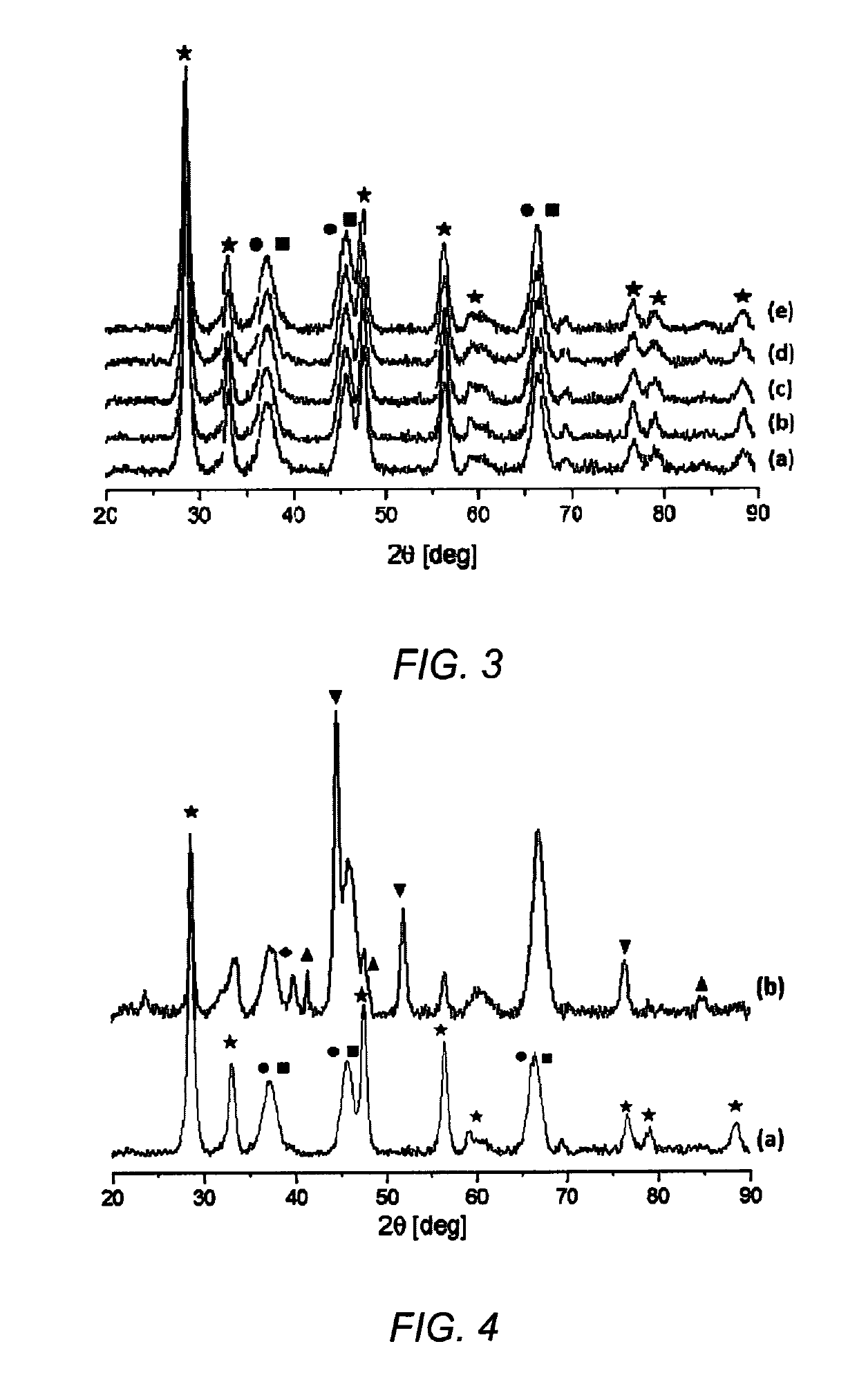Synthesis of oxygen-mobility enhanced CeO2 and use thereof
a technology of enhanced ceo and oxygen, which is applied in the direction of physical/chemical process catalysts, bulk chemical production, metal/metal-oxide/metal-hydroxide catalysts, etc., can solve the problem of increasing associated costs, reducing efficiency production, and increasing reaction conditions for methane dry reforming. problems, to achieve the effect of increasing mechanical strength, reducing production costs, and high defect concentration
- Summary
- Abstract
- Description
- Claims
- Application Information
AI Technical Summary
Benefits of technology
Problems solved by technology
Method used
Image
Examples
example 1
Synthesis of Catalysts with Al2O3 Core Material
[0074]Materials: Metal precursor salts for the core-shell structured catalysts of the present invention were obtained from Sigma Aldrich Chemical Company (St. Louis, Mo., USA) and used as received. Core material (γ-Al2O3 ⅛″ pellets) was obtained from Alfa Aesar, Stock#43832. The BET surface area of γ-Al2O3 was measured and found to be 231 m2 / g.
[0075]General Procedure: A procedure for preparation of one of the core-shell catalysts of the present invention is described. The core-shell catalysts listed in Table 1 were prepared using similar protocols. Table 1 lists the redox-metal oxides, metal dopants, and active metal and the amount of each in the catalyst.
[0076]Step 1: cerium ammonium nitrate (2.86 g) and indium chloride (0.19 g) were dissolved in deionized water (7.2 ml). The resultant solution was impregnated with gamma-Al2O3 extrudates (6.0 g). The resulting impregnated material was dried at 80° C. in an oven under the flow of air. D...
example 2
Characterization of Catalysts of Example 1
[0079]All samples from Example 1 were characterized by powder X-ray analysis for phase determination. FIG. 3 are X-ray diffraction patterns for NiRh / In—CeO2, NiRh / Nb—CeO2, NiRh / Ga—CeO2, NiRh / La—CeO2, and NiRh / CeO2 catalysts having the compositions listed in Table 1. Pattern (a) is NiRh / In—CeO2 catalyst, pattern (b) is NiRh / Nb—CeO2 catalyst, pattern (c) is NiRh / Ga—CeO2 catalyst, pattern (d) is NiRh / La—CeO2 catalyst, and pattern (e) is NiRh / CeO2 catalyst. The phases corresponding to CeO2 (Star): ICDD=00-043-1002, Al2O3 (Square): ICDD=01-073-6579 and NiO (circle): 01-089-8397 were noticeable. Since the XRD patterns were similar in nature, the synthesis of the core-shell catalyst was determined to be reproducible. The broaden peak width at half height of the peaks at 37°, 46° and 67° is due to overlapping of the Al2O3 and NiO diffraction peaks, and not by the small size of the crystallites. The weight percentage of Rh (2.5 wt %) and dopant (1.43...
example 3
Calculation of Oxygen-Vacancy Formation Energy (eV) for the Catalysts of Example 1
[0080]The oxygen-vacancy formation energy (eV) of the catalysts from Example 1 were calculated using Vienna ab initio simulation program (VASP). The calculations were carried out at the DFT-GGA+U level (Density Functional Theory (DFT)—Generalized Gradient Approximation (GGA), plus Hubbard parameter) using a metal dopant content of about 7 wt. % and the most stable CeO2(111) surface. Table 2 lists the dopant / CeO2 combination and the oxygen-vacancy formation energy (OVF) values. From the calculations, it was determined that the percentage of oxygen vacancy was equal to about 3%. It was also determined that the Ga— and In-doped CeO2 systems had the lowest oxygen-vacancy formation energies. Based on these calculations, the oxygen mobility was predicted to be the easiest in the Ga— and In-doped CeO2 core-shell catalysts of the present invention, which confirms the data showing that the core-shell catalysts ...
PUM
| Property | Measurement | Unit |
|---|---|---|
| temperature | aaaaa | aaaaa |
| temperature | aaaaa | aaaaa |
| temperature | aaaaa | aaaaa |
Abstract
Description
Claims
Application Information
 Login to View More
Login to View More - R&D
- Intellectual Property
- Life Sciences
- Materials
- Tech Scout
- Unparalleled Data Quality
- Higher Quality Content
- 60% Fewer Hallucinations
Browse by: Latest US Patents, China's latest patents, Technical Efficacy Thesaurus, Application Domain, Technology Topic, Popular Technical Reports.
© 2025 PatSnap. All rights reserved.Legal|Privacy policy|Modern Slavery Act Transparency Statement|Sitemap|About US| Contact US: help@patsnap.com



